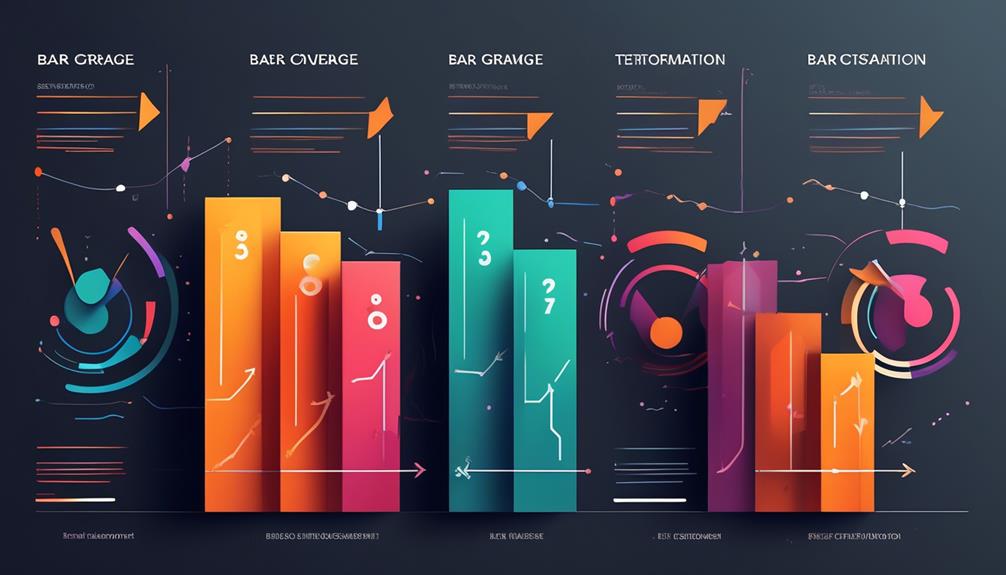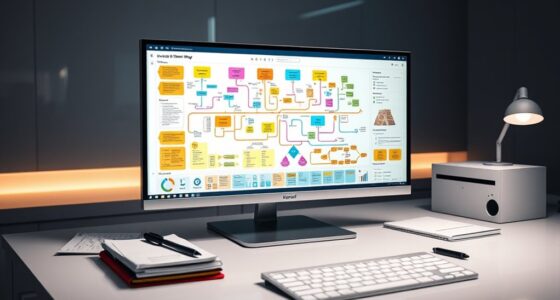Do you think your QA methods are flawless? Think again. Improving QA practices is an ongoing effort that we are all involved in, whether we realize it or not.
It’s not just about fixing what’s broken; it’s about constantly evolving to meet the ever-changing demands of software development.
So, what exactly drives this ongoing evolution? Join me as we explore the key factors that fuel the relentless pursuit of perfection in QA processes, and how they can make or break the success of your software development endeavors.
Key Takeaways
- Continuous improvement in QA processes ensures ongoing enhancement of software development processes.
- Clear objectives help set measurable goals for tracking progress and identifying areas for improvement.
- Measurable progress tracking is essential for driving continuous improvement and ensuring alignment with organizational goals.
- Communication and reporting practices encourage open and transparent communication for prompt issue resolution and progress updates.
The Importance of Continuous Improvement
Continuous improvement in QA and testing is an indispensable practice for ensuring the ongoing enhancement of software development processes and the delivery of high-quality, reliable products. In the realm of software development, the significance of continuous improvement in QA processes can’t be overstated. It’s the linchpin for driving excellence and innovation in the industry.
By continuously refining our QA processes, we proactively seek out and implement changes that elevate the standard of our software development. This iterative approach not only fosters a culture of improvement but also leads to tangible benefits such as reduced expenses, increased productivity, and heightened customer satisfaction.
Continuous improvement in QA processes is the bedrock of ensuring that our products meet the highest standards of quality. This iterative process of refinement allows us to stay abreast of the evolving landscape of software development, testing methodologies, and customer expectations.
Establishing Clear Objectives

We must emphasize the importance of setting clear and measurable objectives in our QA processes.
By establishing precise goals, we can effectively track our progress and identify areas for improvement.
This approach allows us to align our efforts with the organization’s trajectory, increasing employee buy-in and cohesion.
Clear Goal Setting
Establishing clear objectives is fundamental for driving a strategy of continuous improvement in QA and testing. Clear goal setting ensures that the QA process aligns with the organization’s overall trajectory and goals. It fosters a culture of improvement by providing a roadmap for the QA team to follow.
Additionally, communicating the importance of the QA process and its objectives ensures employee buy-in and understanding, thus creating cohesion within the team. Using clear and concise language to define objectives helps in establishing a common understanding of the desired outcomes and fosters alignment. This facilitates the implementation of feedback loops and best practices, enabling the QA team to continuously improve the quality of processes and testing methodologies.
- Alignment with organizational goals
- Fostering a culture of improvement
- Employee buy-in and understanding
- Common understanding and alignment
Measurable Progress Tracking
Measuring progress in the QA process against clear and achievable objectives is essential for driving continuous improvement and ensuring alignment with organizational goals. Establishing specific, measurable goals allows for effective tracking of progress and timely adjustments in the testing process.
Measurable progress tracking enables transparent reporting of achievements and areas needing improvement, ensuring high quality in testing activities. It also fosters accountability and promotes a culture of continuous improvement in the QA and testing environment.
Communication and Reporting Practices
Utilizing clear communication channels and standardized reporting formats is essential for facilitating effective information flow within the QA process. By encouraging open and transparent communication, we can promptly address issues and share progress updates, fostering a culture of collaboration and knowledge sharing. Regular reporting on QA activities, findings, and progress to stakeholders ensures alignment and transparency, while also providing a means to track and measure the impact of continuous improvement efforts in QA processes.
- Open and Transparent Communication: Encouraging an environment where team members feel comfortable sharing their insights and concerns can lead to more effective problem-solving and idea generation.
- Regular Reporting to Stakeholders: Providing stakeholders with regular updates on QA activities and progress ensures that everyone is informed and aligned, allowing for timely adjustments and decision-making.
- Impact Tracking: Utilizing reporting practices to measure the impact of continuous improvement efforts enables us to identify areas for further enhancement and celebrate successful initiatives.
- Collaboration and Knowledge Sharing: Effective communication and reporting practices facilitate the sharing of best practices, lessons learned, and insights gained from peer reviews, test plans, automation software, and development processes.
Shifting Left and Automation

Shifting left in the QA process involves involving QA teams from project inception to start testing at the beginning of the software development lifecycle, thereby enhancing the overall efficiency and effectiveness of the testing phase.
By integrating QA engineers early on, organizations can ensure that potential issues are identified and resolved at an earlier stage, reducing rework and enhancing test coverage.
Automation plays a pivotal role in this process, as it allows for the execution of repetitive test cases, thereby saving time and decreasing the chance of human error. Tools such as Selenium, Appium, and TestComplete enable organizations to automate various aspects of the testing processes, including regression testing and cross-browser testing.
Moreover, practices like test-driven development (TDD) and continuous integration and deployment further contribute to the automation of the software development process, lowering the likelihood of bugs and errors.
Additionally, the adoption of root cause analysis and code reviews supports continuous improvement by identifying underlying problems and ensuring that the software meets the required quality standards.
Developing Test Planning Strategies

First, let’s examine our test coverage strategies to ensure that we’re addressing all critical areas of the application.
Next, we should consider implementing risk-based testing techniques to prioritize our testing efforts based on potential impact and likelihood of failure.
Lastly, we need to align these strategies with our overall objectives to ensure that our test planning is focused and effective.
Test Coverage Strategies
To ensure comprehensive test coverage across various aspects of the software product, it’s essential to develop meticulous test planning strategies within the QA department. Test coverage strategies play a critical role in continuously improving testing practices and aligning them with the project’s objectives.
Here are some key considerations for effective test coverage strategies:
- Define success metrics for regression testing, performance testing, security testing, and usability testing.
- Incorporate automation tools such as TestRail, Selenium, Gatling, Jira, and Sonarqube to enhance test coverage and efficiency.
- Ensure that test planning guidelines align with the development process and contribute to the improvement of QA processes.
- Facilitate knowledge sharing within the QA team to enhance test coverage strategies and promote continuous improvement.
Risk-Based Testing Techniques
Implementing risk-based testing techniques is crucial for developing effective test planning strategies that prioritize and address critical areas of the product. By utilizing risk analysis techniques, we can identify and prioritize high-risk areas for testing, ensuring that potential failure points are thoroughly examined. This approach allows for the development of tailored test plans that specifically target these high-risk areas, thus improving test coverage and the overall quality of the product. To illustrate the impact of risk-based testing techniques, consider the following table:
| Risk-Based Testing Techniques | Benefits |
|---|---|
| Prioritization of testing efforts | Focus on critical areas |
| Tailored test plans | Address high-risk areas effectively |
| Comprehensive test strategy | Ensures thorough coverage |
| Flexibility for adjustments | Adapts to changing risk factors |
| Improved product quality | Meets consumer expectations |
Measuring and Updating Success Metrics

Measuring and updating success metrics is a critical component of driving continuous improvement in QA processes, providing valuable insights for enhancing overall effectiveness. By regularly assessing and updating success metrics, we ensure their alignment with business goals and relevance to current objectives. This practice enables us to identify areas requiring improvement and guides decision-making for process enhancements.
Up-to-date success metrics provide actionable insights for continuous improvement, contributing significantly to the overall effectiveness of QA processes. Adapting success metrics based on changing business needs, industry trends, and customer feedback is crucial for driving continuous improvement in QA processes. Our approach involves leveraging automated testing to gather relevant data continuously and applying the Kaizen philosophy of incremental improvement.
Additionally, we integrate QA consulting to stay attuned to industry best practices and customer satisfaction. This commitment to dynamic success metrics ensures that our QA processes remain test-driven and responsive to evolving needs, fostering a culture of continuous improvement.
Implementing Knowledge Transfers and Feedback

Continuously updating success metrics ensures the alignment of our QA processes with business goals and current objectives, creating a foundation for implementing knowledge transfers and feedback.
By establishing channels for sharing information and experiences among QA professionals, we foster a culture of continuous improvement. Feedback loops play a crucial role in integrating insights from testing and quality assurance activities into our improvement process. Actively seeking and incorporating feedback from stakeholders, users, and team members drives sustained excellence in our QA practices.
Furthermore, knowledge transfers facilitate the dissemination of best practices, lessons learned, and innovative approaches within the QA team, allowing professionals to effectively work towards implementing improvements. Building a culture of continuous improvement through knowledge sharing and feedback not only encourages innovation but also fosters a learning environment within the QA team.
This strategic approach ensures that our QA processes remain dynamic, adaptable, and continuously evolving, ultimately leading to a higher level of excellence in our practices.
Frequently Asked Questions
What Is Continuous Improvement in Qa?
Continuous improvement in QA refers to the ongoing process of identifying and implementing changes to enhance the quality assurance and testing practices.
It involves regular evaluation and fine-tuning of software development methodologies, tools, and processes.
By doing so, we ensure that the finished products meet the intended quality standards, reduce costs, and increase efficiency.
This iterative approach allows us to continuously elevate the overall quality of our software products and services.
What Is the Driving Process of Continuous Improvement?
Improvement in QA processes is fueled by a combination of factors.
We leverage data-driven insights, stakeholder feedback, and industry best practices to drive continuous enhancement.
Our focus on proactive issue detection, early resolution, and iterative development ensures a robust quality assurance framework.
Embracing tools for automated testing, continuous integration, and root cause analysis empowers us to adapt and evolve.
Ultimately, the driving force behind continuous improvement lies in our commitment to delivering exceptional software products.
What Are the 4 Components of Continuous Improvement?
The four components of continuous improvement encompass stakeholder feedback, root cause analysis, metrics implementation, and professional development. These elements foster a culture of ongoing enhancement and effectiveness in QA processes.
Stakeholder engagement ensures alignment with needs, while root cause analysis prevents recurring issues. Metrics and KPIs drive data-driven decisions, and investing in training nurtures skill development.
These components collectively drive sustainable improvement in QA processes, ensuring quality and efficiency.
What Are the 5 Key Principles of Continuous Improvement?
The five key principles of continuous improvement encompass:
- A relentless pursuit of perfection.
- A commitment to empirical decision-making.
- A focus on optimizing the whole system rather than its individual parts.
- A dedication to amplifying learning.
- A respect for people and processes.
These principles drive our QA processes to evolve and flourish, ensuring that we consistently deliver high-quality, innovative solutions.
Conclusion
In conclusion, continuous improvement in QA processes is crucial for ensuring the quality of software products and staying competitive in the market. By establishing clear objectives, improving communication, and implementing automation, businesses can detect and resolve issues early on, leading to higher customer satisfaction and reduced expenses.
It’s imperative to measure success metrics and constantly update strategies to adapt to changing needs. Embracing continuous improvement isn’t just a choice, but a necessity for long-term success.









